Having a home gym setup can be a game-changer for those who value convenience and cost-effectiveness in their fitness routine. According to Cleveland Clinic exercise physiologists Katie Lawton and Chris Dempers, many people prefer working out at home due to the convenience and cost savings.
A home gym allows you to save time and money while tailoring your workout to your individual fitness goals. Fitness enthusiast Taylor Jones highlights the time saved by having a home gym, making it an attractive option for those with busy schedules.
Key Takeaways
- Convenience is a top reason for preferring a home gym.
- A home gym setup can be cost-effective in the long run.
- Having a home gym allows for personalized workouts.
- Time savings is a significant benefit of a home gym.
- A well-planned home gym can help achieve individual fitness goals.
The Benefits of Having Your Own Workout Space
The benefits of having a home gym are numerous, ranging from saving time to increasing the consistency of your workouts. By having your own workout space, you eliminate the need to commute to a gym, saving you a significant amount of time.
Time and Money Savings Over Commercial Gyms
A home gym saves you money in the long run by eliminating monthly gym membership fees. According to Taylor Jones, having a home gym can save up to 120 hours a year that would otherwise be spent commuting.
Key savings include:
- No monthly membership fees
- Reduced travel time
- No need for expensive gym attire
Privacy and Comfort for Distraction-Free Workouts
Working out at home provides the privacy and comfort needed for distraction-free workouts. You can focus on your exercises without being self-conscious or distracted by others.
This privacy can be particularly beneficial for those who feel intimidated in a commercial gym setting.
24/7 Access Regardless of Weather or Schedule
One of the most significant advantages of a home gym is the ability to work out at any time, regardless of the weather or your schedule. This flexibility makes it easier to maintain a consistent workout routine.
Benefits of 24/7 access include:
- Working out at your most convenient time
- Avoiding peak gym hours
- Exercising in the comfort of your own home
Assessing Your Available Space
To start building your home gym, you need to consider the spaces you have available and how they can be utilized effectively. Assessing your home’s layout is crucial in determining the best spot for your workout area, ensuring that it is both functional and comfortable.
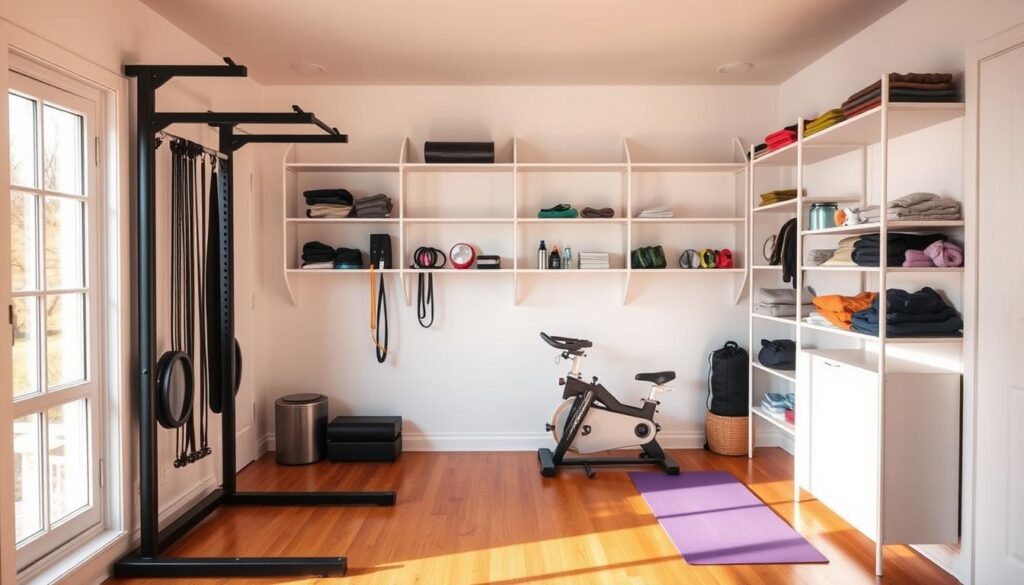
Minimum Square Footage Requirements for Different Workout Types
The amount of space needed for a home gym varies depending on the type of workouts you plan to do. For example, a yoga or Pilates practice requires less space compared to a weightlifting or cardio-intensive workout. Generally, a minimum of 50-70 square feet is recommended for a basic home gym setup.
Utilizing Basements, Garages, and Spare Rooms
Basements, garages, and spare rooms are ideal locations for a home gym due to their privacy and potential for minimal distractions. When converting one of these areas, consider factors like ventilation, lighting, and flooring to create a comfortable workout environment.
- Basements: Often underutilized, basements can be perfect for a home gym, offering natural seclusion.
- Garages: Converting a garage into a home gym can be as simple as clearing out space and installing appropriate flooring.
- Spare Rooms: Spare bedrooms can be easily repurposed into home gyms, especially if you’re looking for a more traditional gym setup.
Creating Workout Zones in Shared Living Areas
In cases where dedicated space is not available, creating a workout zone within a shared living area is a viable alternative. This can be achieved by designating a specific area for your gym equipment and ensuring it is organized and unobtrusive.
By carefully assessing your available space and considering your workout needs, you can effectively create a home gym that is both functional and motivating.
Creating a Home Gym: Fitness at Your Convenience
Creating a home gym is a personal journey that requires careful planning and consideration of your fitness goals. It’s about designing a space that motivates you to work out daily and provides the necessary equipment to help you achieve your objectives.
Defining Your Fitness Goals and Exercise Preferences
Before setting up your home gym, it’s crucial to define your fitness goals. Are you looking to build strength, increase endurance, or improve flexibility? According to fitness expert Taylor Jones, “Understanding your fitness goals is key to selecting the right equipment and creating an effective workout routine.” Your goals will dictate the type of equipment you need and the layout of your gym.
Consider your exercise preferences as well. Do you prefer cardio exercises like running or cycling, or do you focus on strength training with weights? Knowing your preferences will help you choose the right equipment for your home gym.
Designing a Space That Motivates Daily Use
Designing a motivating space is just as important as having the right equipment. A well-designed home gym can boost your motivation and make you look forward to your workouts. Consider the ambiance you want to create: bright and energetic, or calm and focused.
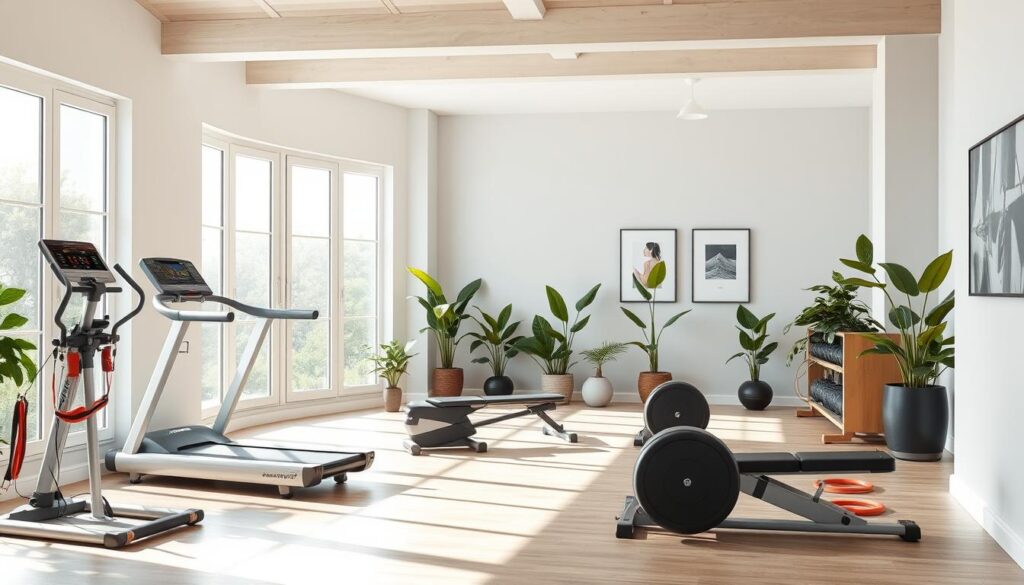
Use mirrors, lighting, and colors to create an atmosphere that inspires you. As fitness enthusiast and blogger, Sarah Jenkins, once said, “A home gym should be a reflection of your personality and fitness style.”
“The right environment can make all the difference in your workout routine.”
Budgeting Strategies for Short and Long-Term Equipment Purchases
Budgeting is a critical aspect of creating a home gym. You need to balance your fitness goals with the cost of equipment. Start by investing in essential items like dumbbells, resistance bands, or a yoga mat.
- Prioritize your needs and allocate your budget accordingly.
- Consider buying second-hand equipment or looking for discounts.
- Plan for long-term equipment purchases, such as cardio machines or strength training equipment.
By following these budgeting strategies, you can create a home gym that meets your needs without breaking the bank. As fitness expert, Mark Davis, suggests, “Investing in a home gym is a long-term investment in your health and fitness.”
Essential Equipment for Beginners
Embarking on a home fitness journey requires some basic yet versatile equipment to get started. As a beginner, it’s essential to invest in gear that is not only effective but also adaptable to different workout routines.
Versatile Basics: Dumbbells, Resistance Bands, and Exercise Mats
For those just starting out, dumbbells are a staple. They can be used for a variety of exercises, from bicep curls to shoulder presses. Resistance bands are another versatile option, offering a lightweight and portable way to work out. They are perfect for strength training and can be used in a variety of exercises, including banded squats and chest presses. An exercise mat provides comfort and grip during floor exercises, such as yoga or Pilates.
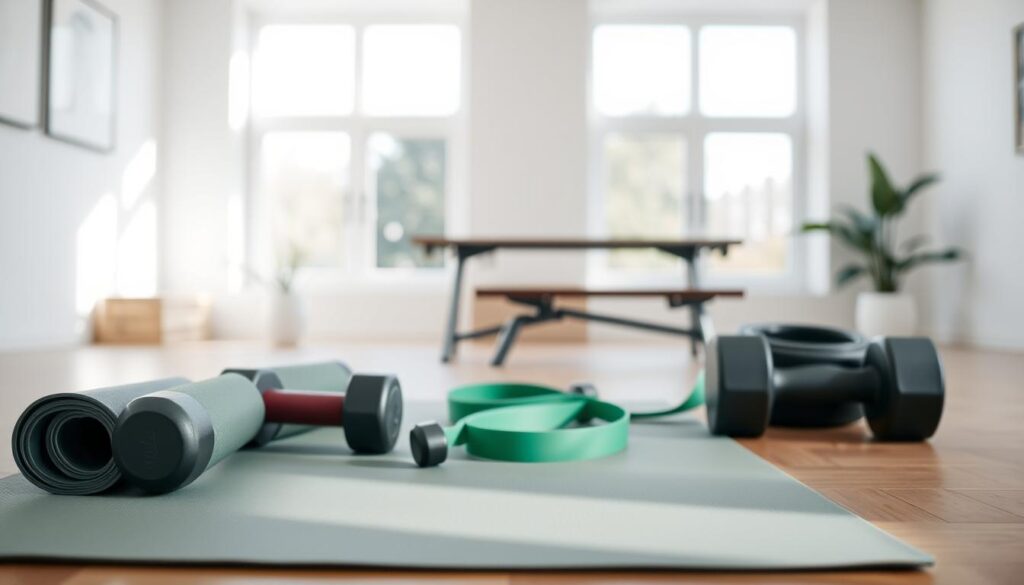
Cardio Options for Limited Spaces
Cardio exercises are a crucial part of any fitness routine. For those with limited space, options like a jump rope or a mini stepper are ideal. They are compact, effective, and can be used in the comfort of your own home. For a more intense workout, consider a foldable treadmill or a stationary bike, both of which can be easily stored away when not in use.
Bodyweight Exercise Stations and Accessories
Bodyweight exercises are a great way to work out without any equipment. However, adding a few accessories can enhance your routine. A pull-up bar can be installed in a doorway, providing a challenging workout for your upper body. Adjustable dumbbells and kettlebells offer variety in strength training exercises.
| Equipment | Benefits | Space Requirement |
|---|---|---|
| Dumbbells | Versatile for strength training | Minimal |
| Resistance Bands | Portable and lightweight | None |
| Exercise Mat | Comfortable for floor exercises | Minimal |
| Jump Rope | Effective cardio workout | None |
By starting with these essential pieces of equipment, beginners can create a well-rounded home gym that meets their fitness needs without breaking the bank or requiring a lot of space.
Advanced Home Gym Setups
As you progress in your fitness journey, you may find that your home gym needs to evolve to meet your changing needs. Advanced home gym setups are designed to support serious fitness enthusiasts who require a wide range of equipment to achieve their goals.
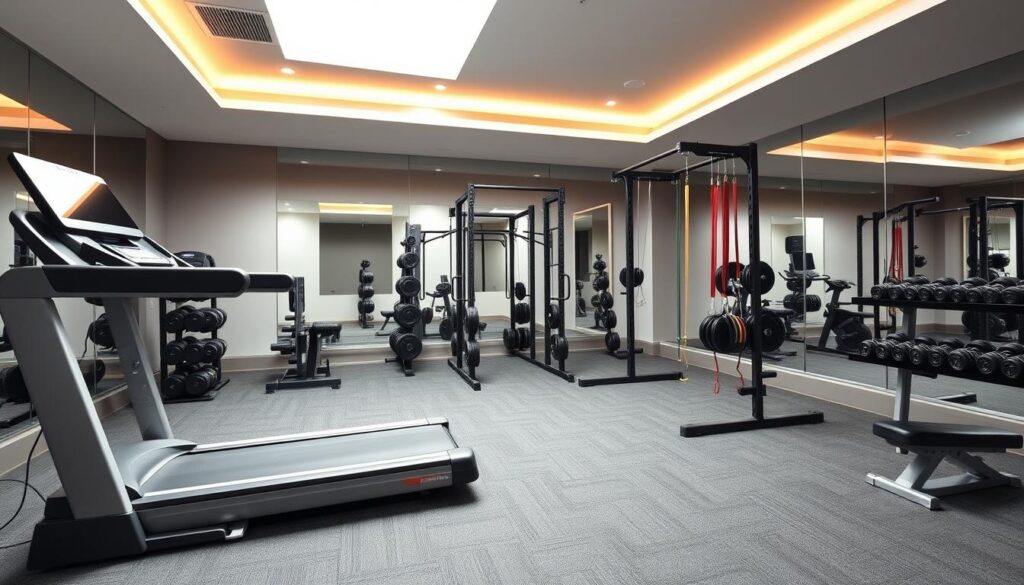
Power Racks, Benches, and Free Weight Systems
A key component of any advanced home gym is a power rack or squat rack, which provides a safe and stable environment for performing heavy lifts. When paired with a bench and free weight system, you can perform a variety of exercises, including squats, deadlifts, and bench presses.
Free weights offer the advantage of working multiple muscle groups at once and can be used in a variety of exercises, making them an essential component of any advanced home gym setup.
Cardio Machines: Treadmills, Bikes, and Rowers
In addition to strength training equipment, advanced home gyms often include a range of cardio machines, such as treadmills, stationary bikes, and rowers. These machines provide a convenient and effective way to improve cardiovascular fitness and burn calories.
Having multiple cardio options allows you to vary your workouts and avoid plateaus, keeping your fitness routine fresh and engaging.
Specialty Equipment for Specific Training Goals
Depending on your specific fitness goals, you may want to consider incorporating specialty equipment into your home gym. For example, if you’re interested in functional training, you may want to include items like kettlebells, battle ropes, or a suspension trainer.
For those focused on strength training, additional equipment like leg press machines or cable crossover systems can be beneficial. The key is to identify the equipment that aligns with your goals and incorporate it into your home gym setup.
Optimizing Your Space for Effective Workouts
The effectiveness of your home gym depends on how well you manage the available space. A cluttered and poorly designed gym can hinder your workout routine, while a well-organized space can boost motivation and efficiency.
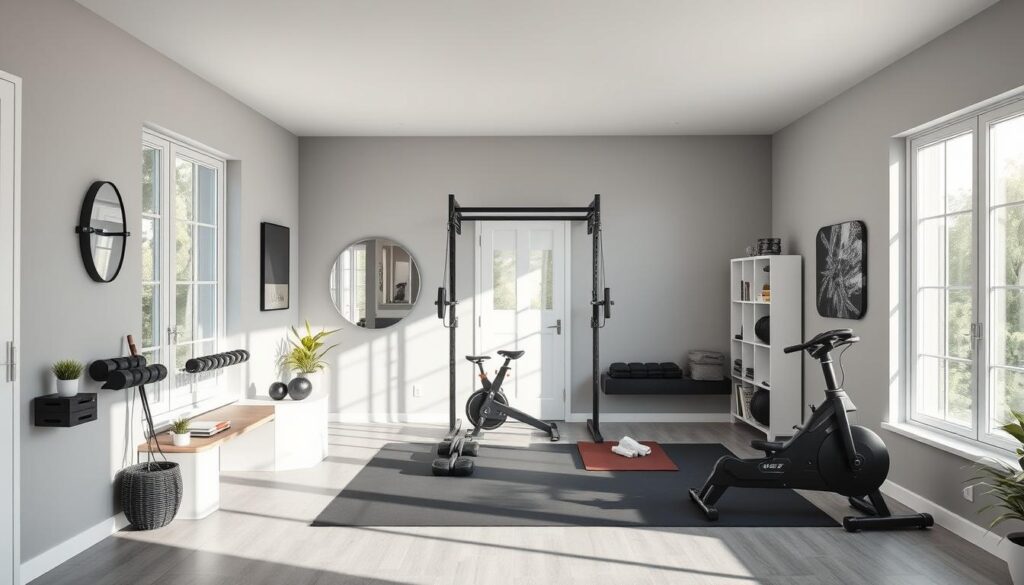
Smart Storage Solutions for Equipment Organization
Effective storage is crucial for maintaining a clutter-free home gym. Consider using wall-mounted racks for dumbbells and resistance bands, or storage bins for smaller accessories. This not only keeps your equipment organized but also frees up floor space, making your gym feel larger and more inviting.
Key storage solutions include:
- Wall-mounted shelves and hooks
- Storage bins and baskets
- Adjustable dumbbell racks
Flooring Options for Protection and Safety
The right flooring can protect both your equipment and your floors. For high-impact activities, consider interlocking rubber tiles or rolled rubber flooring. These options provide shock absorption, reduce noise, and prevent damage to your floors.
| Flooring Type | Benefits | Ideal For |
|---|---|---|
| Interlocking Rubber Tiles | Shock absorption, easy installation | High-impact workouts |
| Rolled Rubber Flooring | Durable, noise reduction | Heavy equipment, high-traffic areas |
Mirrors, Lighting, and Ventilation Considerations
A well-designed home gym also considers environmental factors. Mirrors can create the illusion of a larger space and help with form checks during workouts. Proper lighting, whether natural or artificial, ensures visibility and can enhance the ambiance. Lastly, adequate ventilation is crucial for maintaining a comfortable temperature and air quality.
Tips for environmental considerations:
- Install mirrors strategically to reflect light and create the illusion of space
- Use LED lighting for energy efficiency and brightness
- Ensure proper ventilation with fans or air conditioning units
Creating a Motivating Atmosphere
A motivating atmosphere in your home gym can be the difference between a consistent workout routine and a lackluster fitness journey. To keep you engaged and motivated, it’s essential to create an environment that inspires you to work out daily.
Audio and Visual Setup for Entertainment During Workouts
An effective way to enhance your home gym experience is by incorporating an audio-visual setup. This can include installing a TV, sound system, or even a high-quality speaker to stream your favorite workout playlists or watch motivational videos.
Key Considerations:
- Choose equipment that is durable and can withstand the gym environment.
- Consider wireless options to minimize clutter.
- Ensure that the audio-visual setup is positioned for optimal viewing and listening during workouts.
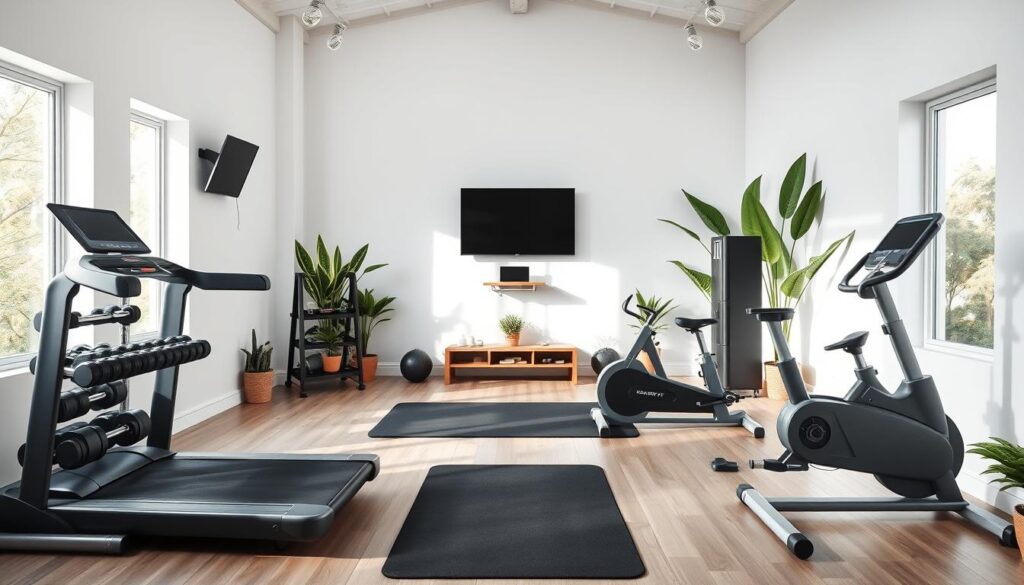
Decorative Elements That Inspire Consistency
The decor of your home gym can significantly impact your motivation. Incorporating elements that inspire you, such as motivational quotes, fitness-themed artwork, or even plants, can make your workouts more enjoyable.
| Decorative Element | Benefit |
|---|---|
| Motivational Quotes | Provides daily motivation and focus. |
| Fitness-Themed Artwork | Creates a gym-like atmosphere, enhancing the workout experience. |
| Plants | Improves air quality and adds a natural touch to the space. |
Temperature Control for Year-Round Comfort
Maintaining a comfortable temperature in your home gym is crucial for year-round comfort and consistency in your workouts. Consider investing in a good heating and cooling system to ensure that your gym remains at an optimal temperature regardless of the outside weather.
Tips for Temperature Control:
- Install a thermostat to easily adjust the temperature.
- Use fans or heaters as needed to maintain a comfortable environment.
- Consider the insulation of your home gym to prevent heat loss or gain.
Effective Workout Routines for Home Gyms
Effective workout routines are the backbone of a successful home gym experience. With the convenience of having your own workout space, you can create a variety of routines that cater to your fitness goals and preferences.
Full-Body Circuits With Minimal Equipment
Full-body circuits are an excellent way to maximize your workout in minimal time. These circuits typically involve a series of exercises that target different muscle groups, and they can be done with minimal equipment. For example, you can do a circuit that includes:
- Burpees
- Mountain climbers
- Dumbbell squats
- Push-ups
- Lunges
These exercises work multiple muscle groups and can be adjusted according to your fitness level.
Progressive Programs for Strength and Endurance
Progressive programs are designed to challenge you over time, helping you build strength and endurance. These programs involve gradually increasing the intensity of your workouts, either by adding weight, reps, or sets. For instance, you can start with a program that includes:
| Exercise | Week 1-2 | Week 3-4 |
|---|---|---|
| Squats | 3 sets of 8 reps | 3 sets of 12 reps |
| Push-ups | 3 sets of 10 reps | 3 sets of 15 reps |
| Lunges | 3 sets of 8 reps (per leg) | 3 sets of 12 reps (per leg) |
As you progress, you can continue to increase the intensity to challenge yourself further.
Adapting Popular Fitness Programs for Home Settings
Many popular fitness programs can be adapted for home gyms. For example, you can follow a modified version of HIIT (High-Intensity Interval Training) or Pilates using your home gym equipment. You can also find online resources and videos that guide you through various workouts.
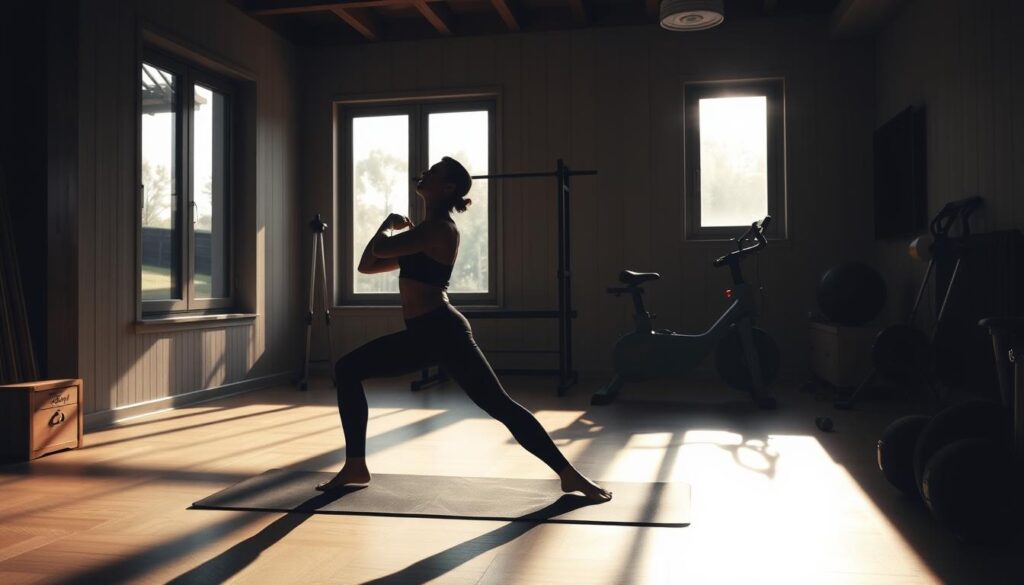
By adapting these programs to your home gym, you can enjoy the benefits of structured workouts in the comfort of your own space.
Conclusion
Creating a home gym offers numerous benefits, including convenience, cost savings, and flexibility. By assessing your available space and defining your fitness goals, you can design a home gym that motivates daily use and helps you achieve your objectives.
A well-planned home gym setup can include essential equipment such as dumbbells, resistance bands, and exercise mats. As you progress, you can add more advanced equipment like power racks and cardio machines. Optimizing your space with smart storage solutions, proper flooring, and adequate lighting will also enhance your workout experience.
The benefits of a home gym are clear: you can work out in the comfort of your own space, 24/7, without the need to commute to a commercial gym. By starting your home gym journey, you can take control of your fitness and achieve your goals more efficiently.
With a home gym, you can enjoy a more personalized and distraction-free workout environment. So, take the first step towards a healthier lifestyle and start building your home gym today.



